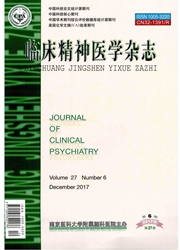

 中文摘要:
中文摘要:
目的:研究探讨丝裂酶原活化蛋白激酶1(MAPK1)基因在中国汉族阿尔茨海默病(AD)发生过程中的作用。方法:根据《美国精神障碍诊断和统计手册》(DSM-IV)和美国国立神经病、语言功能紊乱和脑卒中研究所及AD和相关疾病协会临床诊断标准(NINCDS-ADRDA),收集中国东部和西南部人群AD患者715例和健康对照者760人。选取MAPK1基因3个标签多态性位点rs2276006、rs1063311和rs2006893。采用SNa Pshot SNP分型技术对这3个SNP位点进行分析。结果:中国东部和西南部人群AD组与对照组间MAPK1基因各位点基因多态性及等位基因分布频率差异无统计学意义(P〉0.05);东部及西南部人群合并后AD组与对照组间MAPK1基因各位点基因多态性及等位基因分布频率差异无统计学意义(P〉0.05),连锁不平衡检验显示各SNP位点之间存在强连锁(D'〉0.95),单体型分析结果显示病例组与对照组间单体型估计频率差异无统计学意义(P〉0.05)。结论:MAPK1基因可能不是中国汉族AD的主要致病基因。
 英文摘要:
英文摘要:
Objective: To investigate the association between mitogen-activated protein kinase gene ( MAPK1 ) and Alzheimer's disease (AD) in Han Chinese. Method: According to the AD criteria of Diagnos- tic and Statistical Manual of Mental Disorder(DSM-IV) and National Institute of Neurological and Communica- tive Disorders and Stroke and the Alzheimer'sDisease and Related Disorders Association, (NINCDS-ADRDA) , two independent samples from Southwest China and East China were recruited. Three tagSNPs rs2276006, rs1063311and rs2006893 within MAPK1 gene were selected. We used SNaPshot assay to genotype the three SNPs. Results:There were no significant differences in genotype and allele frequencies between the AD and control groups in either Southwest or Eastern Chinese Han populations ( P 〉 0.05 ). Even after the two populations were combined, no significance was observed in the association of MAPK1 gene and AD(P 〉 O. 05). After calculating LD for all pairs of SNPs,we found strong pair-wise LD( D'〉 0.95 ) between the SNPs. Haplotype a- nalysis showed there was no significant difference in haplotype frequencies between the AD and control groups ( P 〉 0.05 ). Conclusion: The MAPK1 may not be major susceptibility gene for AD in Han Chinese.
 同期刊论文项目
同期刊论文项目
 同项目期刊论文
同项目期刊论文
 期刊信息
期刊信息
